Top Tier CPU Air Coolers Q3 2015: 9-Way Roundup Review
by E. Fylladitakis on July 6, 2015 8:00 AM ESTThe Thermalright Macho Zero
Being one of the oldest and most reputable manufacturers of advanced cooling solutions, Thermalright does not really need much of an introduction in such a review. Ever since 2001, Thermalright is totally focused on designing and producing cooling solutions for PC components, with the mere exception of a heatsink for the XBOX 360. The company greatly surprised us with their submission for this review. With this being a roundup review of top performance coolers, almost anyone would expect to see the Silverarrow or HR-22 (or a Copper TRUE? - Ian). However, Thermalright submitted the Macho Zero - a cooler optimized for passive performance and low airflow environments!
Thermalright supplies the Macho Zero in a very plain black cardboard box, with just a schematic of the cooler printed on it. Inside the box, the cooler is very well protected inside thick polyethylene foam pieces. Note that the Macho Zero is not supplied with a fan. For the means of this review, Thermalright supplied us with a single TY-147A 140 mm fan.
The bundle of the Macho Zero is the most thorough of this review. Thermalright nickel-plated the screws and retention plates necessary for the mounting of the cooler, supplies a tube of quality "Chill Factor III" thermal paste, anti-vibration rubber pads and wire clips for one cooling fan, provides a full size magnetic 150 mm shank Philips PH2 screwdriver and even gloves for the installation of the cooler.
Although the Macho Zero is primarily optimized for semi-passive cooling, meaning that it has been designed to make use of the airflow generated by the fans of the case, it is possible to install any 120 mm or 140 mm fan on it. For the means of this review, the cooler had to be in active configuration, therefore Thermalright supplied us with a TY147A 140 mm fan. The white bladed fan with the rounded frame is a model designed for efficient airflow and low-noise operation. This means that the fan is optimized for low impedance applications, such as to replace case fans. Normally, that would make it mediocre for a very dense cooler, but that is not the case with the Macho Zero. It has a maximum rotational speed of 1300 RPM and an "enhanced hyper-flow bearing", for which we could not find specific information about, but it definitely is a form of fluid sleeve-type mechanism.
The Macho Zero is an imposing, large single tower CPU cooler. Its fins are almost perfectly rectangular, with many openings across their great surface. There are not too many fins though, as the spacing between them is very large in comparison to other coolers. This has been done to optimize this cooler for very low airflow environments and greatly lowers its airflow impedance. For aesthetic purposes, Thermalright painted the top fin black, yet it does not cover the heatpipe endings. There is a fairly large hole near the rear side of the fins, meant for the screwdriver to go through for the mounting of the cooler. Note that for the mounting of this cooler, the front fan (if present) needs to be removed as well.
Typically, the Macho Zero is designed for use without a fan. An optional fan can be used of course, but remember that high airflow / low pressure options are likely to be far more effective than high pressure fans. The provided wire clips are an excellent fit for 140 mm fans with rounded frames, yet their configuration does not allow the adjustment of the fan's height. It would be wise to check the mechanical specifications of the cooler and make sure that the installation of a fan does not restrict the installation of RAM modules in slots that need to be used.
The base of the Macho Zero is of notable importance. The copper base is rectangular and wide to provide full contact with Haswell-E processors, with six 6 mm heatpipes going through it. The heatpipes are split into two groups, with heatpipes 1-3-5 expanding near the rear of the heatsink and heatpipes 2-4-6 near the front. This approach allows the localized generation of a heavy thermal load to be split across the surface of the fins. Everything is nickel plated and the contact surface is treated to a perfect mirror finish.


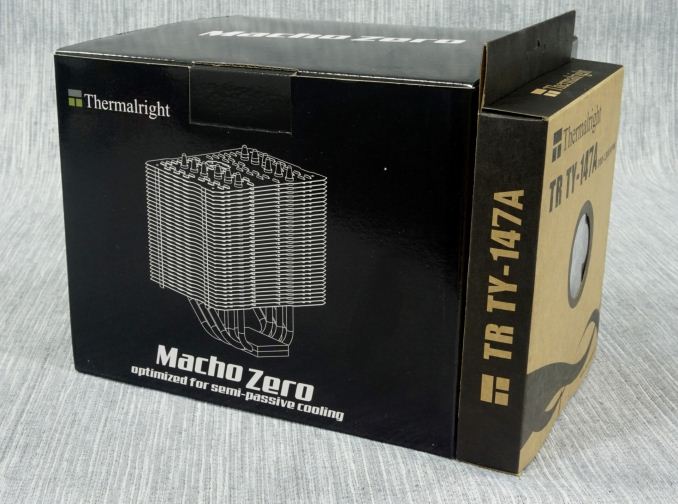
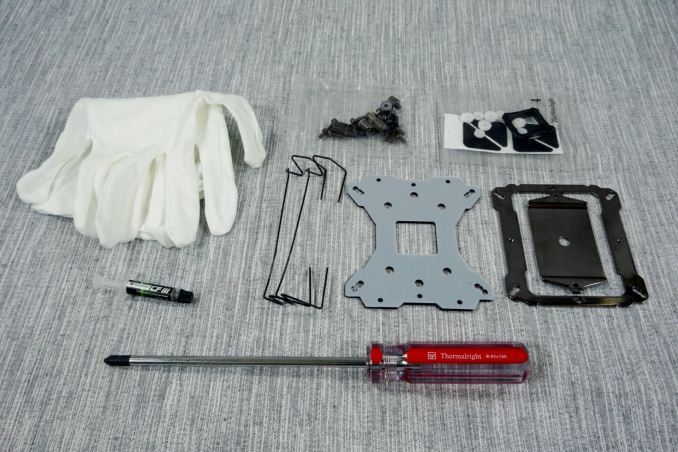
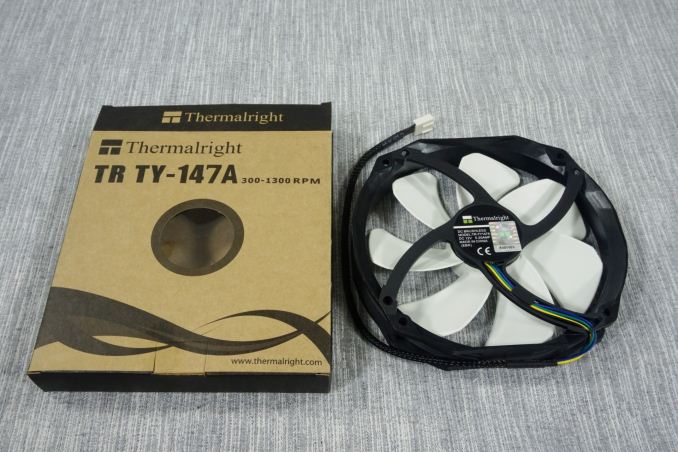
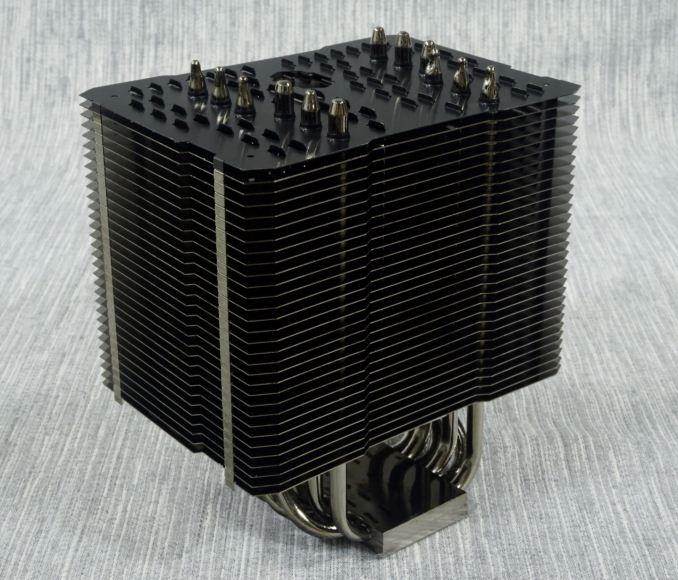
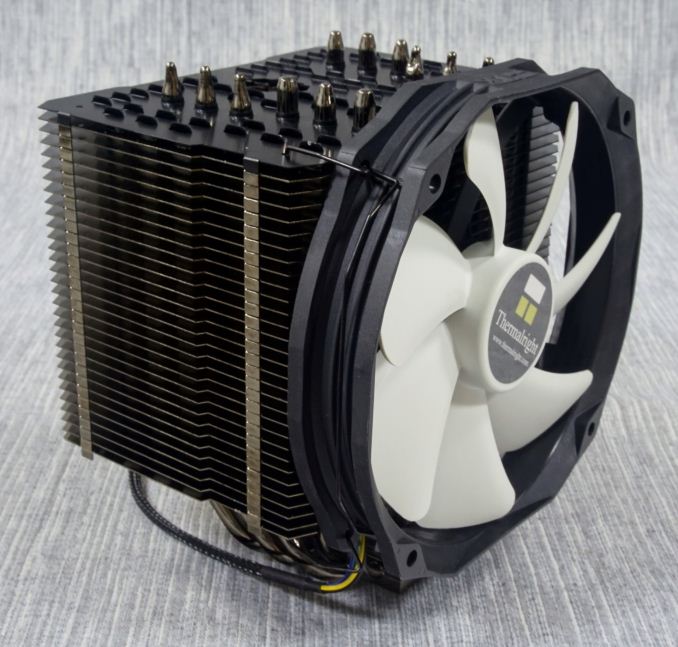
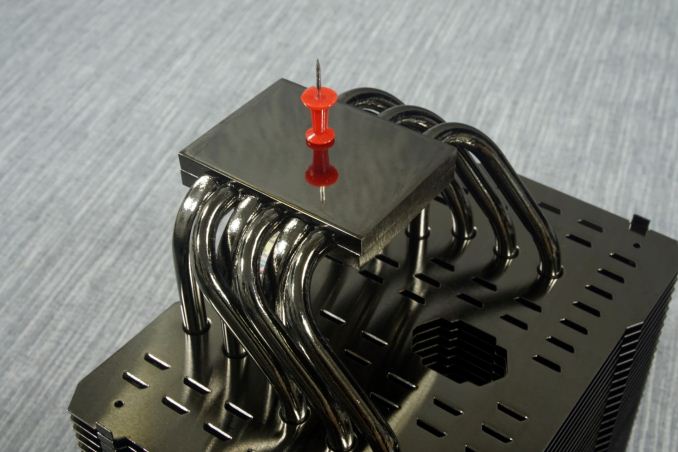








135 Comments
View All Comments
Pissedoffyouth - Monday, July 6, 2015 - link
I wonder how a D15 or similar, with the fans removed, would work with a 45w or 65w APU to make a passively cooled PC.ImSpartacus - Monday, July 6, 2015 - link
That's a really interesting consideration.MrSpadge - Monday, July 6, 2015 - link
This will depend greatly on your case airflow. And if you only run short load bursts (browsing etc.) which can easily be absorbed by the heatsink heat capacity or continous loads (games, work), where the exchange of heat from the heatsink to the outside world limits cooling.iamezza - Tuesday, July 7, 2015 - link
With good fan control you could set the fan to switch off below a certain temp. So it could be silent 99% of the time but with a low rpm fan there if needed.Mumrik - Tuesday, July 7, 2015 - link
You'd probably still need some level of airflow.I've never had a fan on my Scythe Ninja that cools an i5-2500k. I think that's a 95W TDP.
It's close to the single 12cm rear exhaust though.
Beany2013 - Wednesday, July 8, 2015 - link
I did similar with my old SLACR Q6600 95w CPU - Noctua D14 (I think) with a fan on a controller. At stock speeds (with a pair of Noctua case fans on it) it had just enough airflow to run without the CPU fan running at all. When I wanted performance, I could overclock from 2.4ghz to 3.something ghz (I can't remember but I think they went to 3.6ghz?) and just turn the CPU fan up to 'normal' speeds and it'd never get above 70deg and it was still a very quiet machine - HDD noise was far more noticeable than fan noise.I really must get some decent fans for my current rig - a slightly long-in-the-tooth A8-3870 mit 16gb RAM that is still running the OEM cooler. Yes, I've got bored of overclocking. I still have that noctua kit kicking around somewhere, really must dig it out and see if I can get an adapter for it. I'm sure that'll tide me over till we see if Zen is worth a light...?
Essayjedii - Friday, July 10, 2015 - link
I have made a post about D15 in here <a href="http://www.dumblittleman.com/2015/04/14-problems-f... Hope ou find it interesting and useful.Essayjedii - Friday, July 10, 2015 - link
I have made a post about D15 in here http://www.dumblittleman.com/2015/04/14-problems-f...Hope ou find it interesting and useful.
Haravikk - Sunday, July 12, 2015 - link
My current machine is an i7-4790T (45W, 2.7ghz, quad-core, hyper-threaded, 3.9ghz turbo with HD4600 graphics) in an Akasa Euler case, which means the case acts as a heat-sink. As I type this I'm transcoding video on all eight hardware threads with a total load of about 760% (where 800% is max), at a CPU temperature of 85ºC and a clock speed of 2.97ghz.Of course that's for a passive case rather than a heat-sink on its own, but as long as you have somewhere for that heat to go it definitely seems doable. For example if you used an open-air case then ought to just rise out between the heatsink fins so airflow may not be required at all.
Basically keeping the case from becoming a big box of hot air is crucial; the Euler case with my processor (which is a slightly higher TDP than the 35W that the case recommends) gets pretty hot internally, which isn't great for internal drives. I ended up having to swap an mSATA SSD for a 2.5" one, as the mSATA drive just got too hot, while the 2.5" one has a bigger surface area and a metal body. Even so, I squeezed a tiny 40mm fan inside just to help pull hot air out on warmer days.
So ehm… yeah, possible, but you have to be sure you've considered where that heat is going to go before you attempt it. But as others have said; if your case has room then you should just put fans in there anyway and set them to switch off at lower temperatures; you can also use very slow, quiet fans so even if they do run they're silent.
Oxford Guy - Tuesday, July 14, 2015 - link
Stick with a cooler like the NoFan models which are made specifically passive cooling. They will be much more effective.